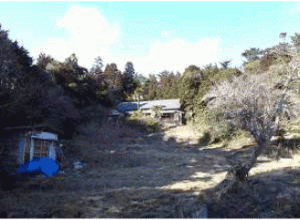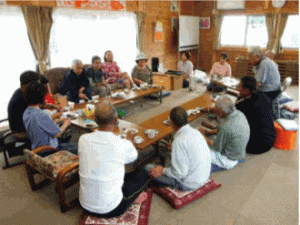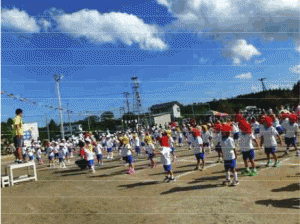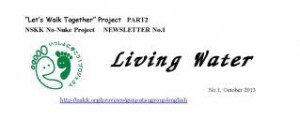
Newsletter of the “Project on Nuclear Power and Radiation” — Part II of the “Let’s Walk Together” Project, the Anglican-Episcopal Church in Japan’s efforts to “walk together” with victims of the Great East Japan Earthquake of March 2011
“Let’s Walk Together” Project Living Water
Volume 8, September 2015
http://www.nskk.org/province/genpatsugroup/English.html (Linked to the Provincial Office’s website)
(Translated into English from the original Japanese by Heeday.
The English translation edited by Rev. Dr. Henry French, ELCA, except for the Protest Statement and the donation information)
A Protest Statement against the Restart of the Sendai Nuclear Power Plant (Kagoshima, Japan)
Addressed to:
Mr. Shinzo Abe, Prime Minister of Japan
Mr. Michiaki Uriu, President, Kyushu Electric Power Co., Inc.
Issued by:
The Right Reverend Ichiro Shibusawa, Chairperson, the Peace and Justice Committee of Nippon Sei Ko Kai (the Anglican-Episcopal Church in Japan)
Reverend Kenzo Koshiyama, Acting Chairperson, the “Project on Nuclear Power and Radiation” of Nippon Sei Ko Kai
Date: August 14th, 2015
A Protest Statement against the Restart of the Sendai Nuclear Power Plant
Kyushu Electric Power Co., Inc. has restarted Sendai Nuclear Power Plant’s Unit 1 reactor on August 11th. It is clear that the Abe Cabinet and respective power companies intend to fast-track the process of restarting existing nuclear plants without proper debate and consensus while taking advantage of the examination procedure as a test run, their main concern is to maintain Japan’s reliance on nuclear energy. Furthermore, serious issues pointed out in the proposed emergency escape plan for the Sendai NPP make it obvious that the facility is ill-prepared for an impending disaster and various polls show most citizens are vehemently opposed to the restart. The Coordinating Committee for Prediction of Volcanic Eruptions has also been questioning the decisions reached by the Nuclear Regulation Authority, with respect to possibilities of major volcanic eruptions. More importantly, the nation has not secured a disposal area for high-level radioactive waste, nor has it made clear who is responsible in view of a severe accident.
On the other hand, victims of the Fukushima Daiichi Nuclear Power Plant meltdown are still living as refugees with no solution in sight for their woes. Although decontamination work is in progress, it is proven to be rather ineffective as areas with high radioactivity are still prevalent and health concerns of those who live there are constantly mounting because adverse effects of radiation may take years to manifest – possibly in many generations to come.
Nonetheless, Japan’s central government remains very keen on exporting its nuclear technology to other countries as part of its economic growth strategy; they are more than willing to allow nuclear plants from going online to accomplish this goal while being bombarded with harsh criticisms at home and abroad. In short, giving the go-ahead by trampling the people’s will and their well-justified concerns is outrageous and unwise. It is an act of blasphemy to all the victims of the nuclear meltdown if we do not learn from past mistakes.
The correct energy policy for the Japanese government to take on is to decentralize power grids and allowing communities to generate electricity using renewable energy. We have to learn from the experiences of the Fukushima meltdown and make a new start towards a society powered by clean and sustainable energy.
We, the Anglican-Episcopal Church in Japan are against nuclear power which threatens lives created by God, subverts the creation, and deprives people of peace. As Christians, we are fiercely opposed to the restart of any nuclear power plant and hereby urge all such facilities to be decommissioned with immediate effect.
| To donate to us: ◆ Postal transfer account with Japan Post: 00120-0-78536 Account holder: Nippon Sei Ko Kai (NSKK) Please clearly state in the transfer slip “Donation to the Project on Nuclear Power and Radiation Or: ◆ Account Name;NIPPON SEI KO KAI ◆ Address; 65 Yarai-cho, Shinjuku-ku,Tokyo 162-0805 JAPAN ◆ Account Number;4515547 ◆ Bank Name;The Bank of Tokyo-Mitsubishi UFJ, LTD. Branch Name;Iidabashi Bank Address;3-7 Kagurazaka, Shinjuku-ku,Tokyo 162-0825 JAPAN |
“Support Center Shinchi-Gangoya”
– What is it?
Hiroshi Matsumoto, staffer at “Support Center Chinchi-Gangoya” run by the Project on Nuclear Power and Radiation.
Where?
The Center is located in Shinchi Town, Soma-gun, Fukushima Prefecture. The town is on the northern edge of coastal Fukushima, on the border with Yamamoto Town, Watari-gun, Miyagi Prefecture.
Why there?
When the earthquake of 2011 hit, it devastated all four coastal districts of Shinchi Town, home to some 8,000 residents at the time, and claimed 119 lives. The northern district, Isoyama, was where Isoyama St. John’s Church used to stand. This church of the Tohoku Diocese, Anglican-Episcopal Church in Japan, was a community of faith with 12 members from four families. The 2011 earthquake and tsunami resulted in a serious tragedy—it destroyed the houses of all the church’s members, and the lives of three of them were lost. Many people, from both inside and outside of Japan, visit the place as pilgrims and/or volunteers in order to provide the victims with support. Now the Support Center has a resident staffer.
What does it do?
The Center is helping the destroyed church’s members to rebuild their church, and it is also helping Shinchi’s residents rebuild their town. Ever since the 2011 disaster, the Center has been actively holding a broad variety of activities that invite residents to plan, participate, and walk together in response to their changing needs. The Center’s specific activities include, among others, a Wednesday café, finger-pressure massage, visits to victims’ homes, and stretching for health—collectively called “Hotto Corner” (Comfy Time) The Center also sponsors “Listening to Witnesses” events, lectures and pilgrimages.
Saturday, September 19th
Fuji Kindergarten held an athletic meeting under a clear and sunny fall sky. The sunshine was strong and it was almost too warm. Children are our future.
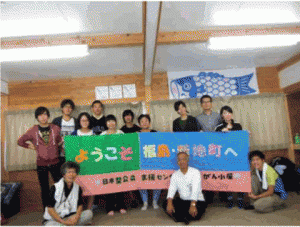
How does the Center stand today, and what are the problems it is facing?
Four and a half years have passed since the March 2011 disaster. By the end of 2015, the temporary housing in the town, which used to be eight in number, are to be integrated into two. While many victims are moving, in large numbers into publicly-run housing (for the aged, for disaster victims, etc.), and with more of such housing being built, the remaining two temporary housing facilities mainly host refugees from the Fukushima Daiichi meltdown. These refugees have no hope in sight of “going back to normal” and their lives as refugees go on and on.
Both for those who have left temporary housing and for those still in such housing, the most urgent need is to “restore their mind and emotions.” People easily speak of “restoration,” yet behind that word lie many serious issues such as “isolation,” “discrepancy in wealth,” “discrimination,” “separation,” “hopelessness,” “grief,” and other equally grave issues.
| Project on Nuclear Power and Radiation This project has been run by a steering committee established under the direction of the “Let’s Walk Together” Project and the 2012 General Synod resolution, “For a World without Nuclear Power Plants,” of the Anglican Episcopal Church in Japan (NSKK). Steering committee members: Revd. Makito Aizawa (Chair), Revd. Akira Iwaki, Revd. Kenzo Koshiyama, Revd. Tazuru Sasamori, Ms. Hiroko Miyawaki. Secretary General: Ms. Kay Ikezumi 2-9-23, Hayama, Koriyama City, Fukushima Prefecture Phone: +81-249-53-5987 Fax: 050-411-7085[Emergency notice] Revd. Kiyoshi Nomura, who used to serve our Project as chairperson of the steering committee, was called up to heaven on September 10, 2015. Revd. Nomura literally shortened his life by working hard for the victims of the 2011 disaster. Please pray for God’s blessings on his spirit. |
My Fukushima experiences of July 2015
Revd. Yuji Kanzaki, priest at the Tokyo Diocese
This July, I visited Fukushima again. I believe I need to visit the place once or twice every year so as not to lose the feel of what happened there. And, so far, no improvement has been made there.
I drove north on the Joban Expressway, which runs from Tokyo to Sendai. After a while, I noticed many black vinyl bags piled up along the way. They contain collected contaminated soil. Contaminated soil from a house garden is collected into vinyl bags—that is the so-called “decontamination work.” Still, if these bags are just piled up in a corner of the garden, what sense does this “decontamination work” make?
In some places, I saw some high piles of these bags, stacked in several tires, at the corners of farms. These piles were laid out in long lines. After all, what can we do to dispose of such collected contaminated soil? Nobody knows yet.
At a corner of the cemetery of Hosenji Temple,Tomioka Town, Fukushima, I found another pile of vinyl bags whose label said, “Collected on June 17th, 2015, 5.14mSv.” I had a dosimeter with me, and I measured the dose. The meter said 11.1mSv, more than double the dose written on the label. What has caused this difference?
As usual, I visited the village office of Iitate Village as well. While a sign said the dose was 0.41mSv at 1m (1.1 yards) above the ground, my measurement on the ground was 1.12mSv. Though the relevant authorities gave people permission to inhabit part of this village, one has to keep in mind that small children are closer to the ground when they play than most adults are. So, children are exposed to greater doses of radiation than officially announced.
Below the radiation dose indicator at the village office, I saw a patch of clover. Whenever I see a patch of clover, I have this habit of searching for a four-leaf clover. So, before I knew it, I was searching for such a clover. Surprisingly, I found 17 four-leaf, five-leaf, and six-leaf clovers within the clover patch, which covered an area of about 1m by 1m (1.1 yards by 1.1 yards). And I did so in only five minutes or so.
In Koriyama, Fukushima, I interviewed two women, both in their 30s. They permitted me to share their stories with readers of this newsletter. So, here are their stories.
One of the two, Ms. A, said that she could not use local tap water or food produced in Fukushima, for the sake of her child’s health. Though radiation is such a serious issue in her everyday life, she could not discuss it with other mothers at her child’s kindergarten. There were some mothers who would argue, “If we worried like that, we wouldn’t be able to make our living!” Thus, talking about radiation was sure to result in icy silence.
For a similar reason, the other woman, Ms. B, said she could not talk about radiation even with her own husband. Thus, this couple was unable to talk about some important life events, such as pregnancy, child birth, child raising, and so on. Her agony painfully disturbed my mind and heart.
Christianity believes in respect for life. From this viewpoint, nuclear power is a deadly obstacle to life.
Sign of the Times
– Column on Current Issues
“The nuclear disaster to calm down”
Every Sunday, in the Eucharistic Prayer, I pray that “the nuclear disaster calm down.”
The local newspapers in Fukushima Prefecture report on the situation at TEPCO’s Fukushima Daiichi Nuclear Power Plant every single day. For instance, their reports cover issues such as the fact that TEPCO has continued building a “frozen soil water shield”—which is a wall of ice that is supposed to prevent underground water from entering the nuclear reactors’ external buildings. Also, TEPCO has continued building more large tanks to store contaminated water. Meanwhile, their September 11th editions reported that the recent deluge caused some rain water containing radioactive substances to run out of the drainage system of Fukushima Daiichi into the Pacific Ocean. Counting suspected yet unconfirmed leakages, this was the seventh leakage of contaminated water into the ocean. According to the papers, since a deluge fills the drainage suddenly, causing contaminated water to run out of it, nobody knows how much water ran into the Pacific or how much radioactive substances the water contained. TEPCO says that it will move the outlet of the power plant’s Drainage K to inside the port beside the plant by the end of this year. How much trust can we put in this promise? The contaminated water from Fukushima Daiichi’s reactors is still growing larger and larger in volume. In addition, we have witnessed one serious problem after another at the plant. I often wonder whether the nuclear disaster will ever “calm down” or not.
Now, four and a half years have passed since the meltdown began. Many agricultural producers and distributors in Fukushima are claiming in advertisements that the prefecture’s products are “safe,” in their efforts to get over the damage done by rumors about such products. At the same time, however, some 110,000 people are still living as evacuees in and out of Fukushima today. We still have a very long way before we see the nuclear disaster “calm down.”
In the middle of a situation like this, the Sendai Nuclear Power Plant’s restart on August 11th was a reckless deed that irritated most Fukushima people, especially those living as refugees. The 2011 tsunami and earthquake hit on March 11th, and thus, in Japanese practice, the 11th day of every month has a special meaning. Many Fukushima people asked, “Why on (August) 11th?” Moreover, the accountabilities for the Fukushima Daiichi disaster—and a possible accident at Sendai—have yet to be clearly defined. The causes of the Fukushima tragedy have not been clearly identified. Thus, the nuclear industry and the relevant authorities have yet to learn well the lessons from Fukushima.
Thus, I will have to keep praying that “the nuclear disaster calm down,” during the Eucharistic prayer. I will not give up hope, while hoping that the day will come when I do not have to say this prayer anymore.(M. N.)

